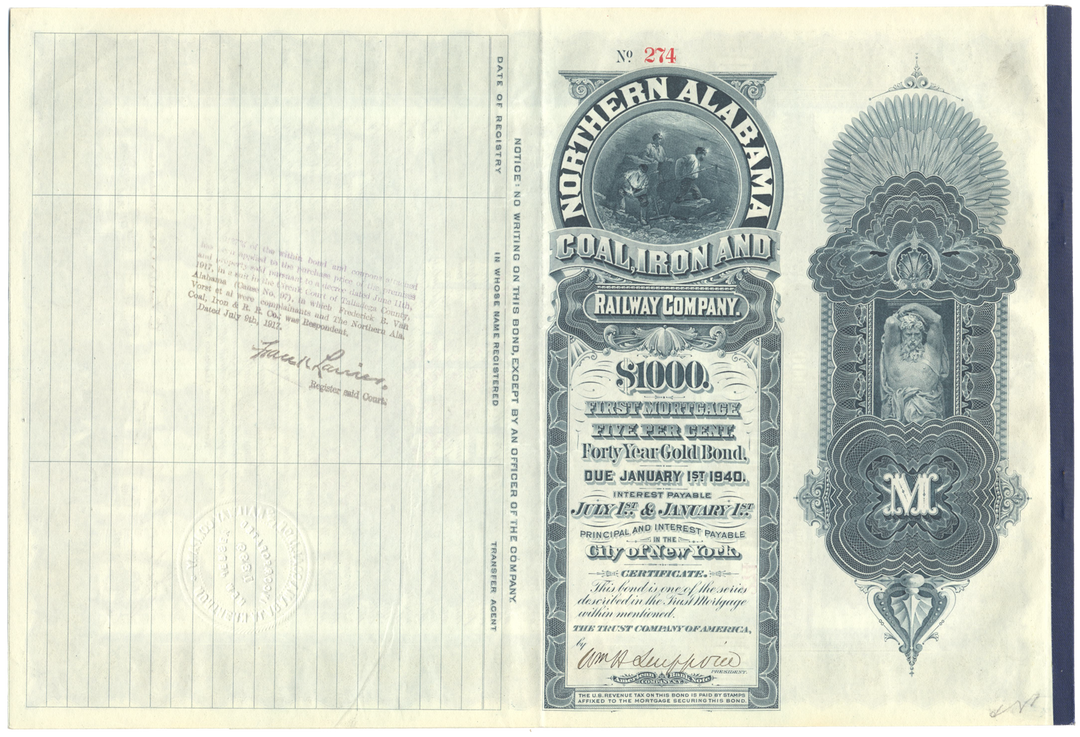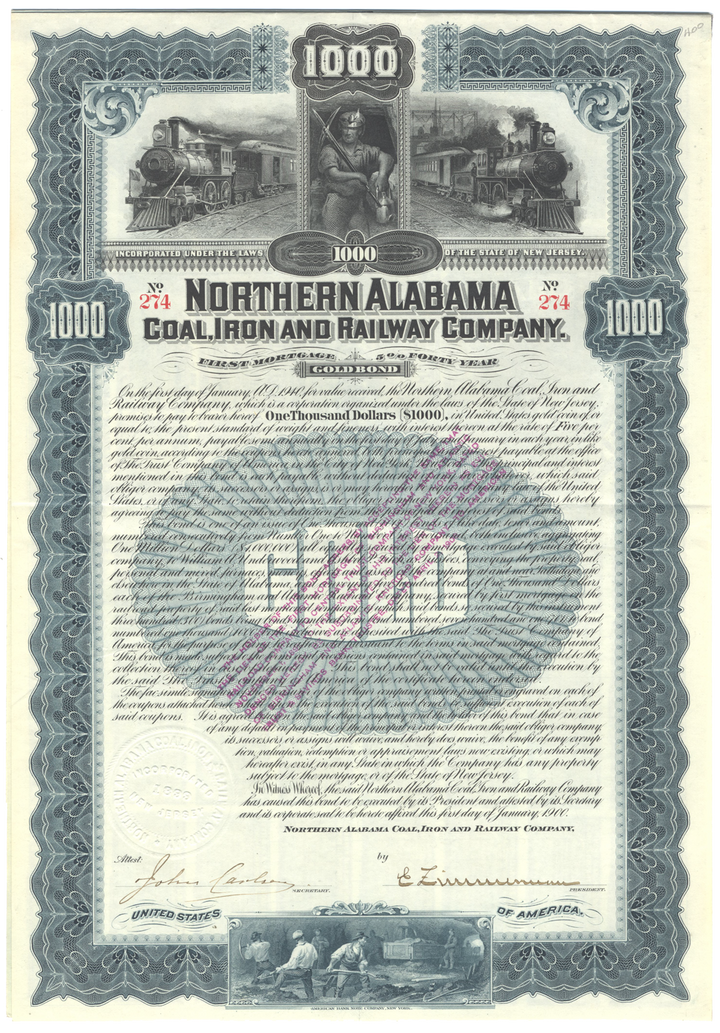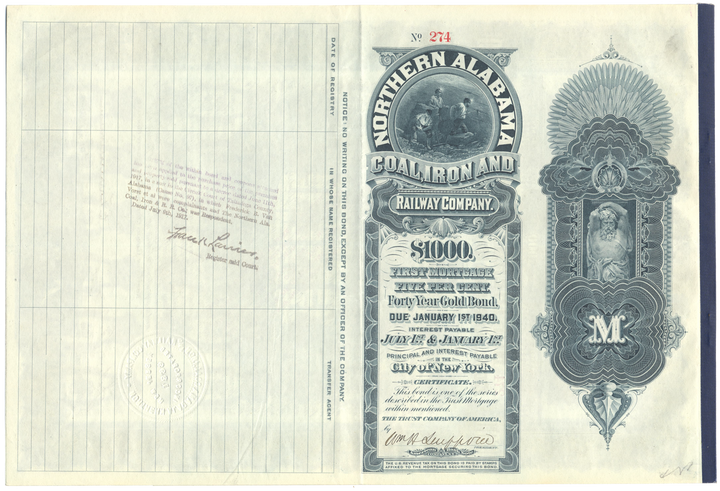Northern Alabama Coal, Iron and Railway Company (Signed by Eugene Zimmerman)
- Guaranteed authentic document
- Orders over $75 ship FREE to U. S. addresses
Product Details
CompanyNorthern Alabama Coal, Iron and Railway Company
Certificate Type
First Mortgage Gold Bond
Date Issued
January 1, 1900
Canceled
No
Printer
American Bank Note Company
Signatures
Hand signed
Approximate Size
9 1/2" (w) by 13 1/2" (h)
Images
Show the exact certificate you will receive
Guaranteed Authentic
Yes
Additional Details
Signed by Eugene Zimmerman
Reference
Historical Context
The Northern Alabama Coal, Iron and Railway Company was originally incorporated on June 16, 1899 in New Jersey as the Alabama Coal, Iron & Railway Company. The following month, the name was changed to the Northern Alabama Coal, Iron and Railway Company.
The company was born out of the assets of the Alabama Iron & Railroad Company, which sold under foreclosure in June 1899. This company was originally known as the Talladega Iron & Steel Company.
The Northern Alabama Coal, Iron and Railway Company owned a blast furnace and several thousand acres of iron ore lands in Talladega County, Alabama, and the standard gauge Birmingham & Atlantic Railroad from Talladega to Coal City.
Eugene Zimmerman
Eugene Zimmerman was born in Vicksburg, Warren County, Mississippi, on December 17, 1845. He grew up at the family's business and was sent to Cincinnati in 1859 to attend Farmer's College. In the spring of 1861, he began attending the preparatory school Gambier Academy with the intention of attending Kenyon College.
When the Civil War broke out, Zimmerman left the Academy and tried to join the Union Navy, but was refused because he was too young. After some modifications, he was accepted, becoming a Master's mate and was assigned to the Mississippi River Squadron.While in the Navy, his ship was struck by torpedo which killed several seamen and threw him into the Yazoo River. He participated in the Battle of Saint Charles and Duvall's Bluffs and served with distinction during the capture of Arkansas Post in 1863, after which he was promoted to Ensign.
During the Vicksburg campaign in his hometown, Zimmerman was placed in charge of a mortar boat and sent up the Yazoo River, making a successful run against the Confederate blockade at Vicksburg in April 1863. During the campaign, he was involved in several missions and was promoted to acting Master and Officer of the side wheel steamer USS Ouachita after the surrender of Vicksburg which he held until the end of the War. During the siege, his former home and his father's business were destroyed.
During the remainder of the war, he was eventually made a Lieutenant and a ship commander at the age of nineteen (the youngest officer at his rank in the entire U.S. Navy). After the War, he resigned his commission, was honorably discharged, and returned to Ohio.
After the war, he went into the oil business, acquiring extensive holdings which he sold to John D. Rockefeller in exchange for shares in Standard Oil where he became a substantial stockholder and gained seat on the company's board. In 1875, Zimmerman purchased more than 13,000 acres of timberland in what is now Yosemite in Casey County, Kentucky. He ran a lumber mill there and built a wooden train track from Kings Mountain to Staffordsville in 1884, later organizing the Green River Railway Co.
He used his income to invest in railroads and was president of the Cincinnati and Green River Railroad, and the Kentucky and South Atlantic Railroad, which later became a part of the Chesapeake and Ohio Railway after he sold it to Collis P. Huntington which led to a long partnership with Huntington, including looking after his interests in the Midwest.
In 1882, he became president of the Chesapeake and Nashville Railway (and constructed the Chesapeake and Ohio Bridge at Cincinnati for Huntington), and in 1888 he was elected president of Dayton, Forth Wayne and Chicago Railway.
In 1904, he was made president of the Cincinnati, Hamilton and Dayton Railway, and succeeded in getting the Queen and Crescent as its tributary and gaining control of the Père Marquette system, and the Chicago, Cincinnati and St. Louis Railroad. George M. Cumming, a lawyer with the United States Mortgage and Trust Company of New York, was elected vice president to represent the interest of New York capital.
In June 1905, Cumming was elected president of the Detroit, Toledo and Ironton Railroad and served for one month; he was succeeded by F. A. Durban who was elected president in July 1905 but resigned in November, and was replaced by Zimmerman. The Detroit, Toledo & Ironton Railway had taken control of the Ann Arbor Railroad from Rudolph Kleybolte & Co. in June 1905. The acquisition connected Toledo with Frankfort, Michigan, and essentially doubled the DT&I system. The DT&I went bankrupt in 1908, forcing them to divest Ann Arbor Railroad to Zimmerman, who sold the line in 1909 to Joseph Ramsey, Jr. and Newman Erb, and retired from active business while still retaining control of his "immense coal and iron lands" in the Midwest.
He continued to be a director of Cincinnati, Indianapolis and Western Railway, the Birmingham and Atlantic Railway and the North Alabama Coal and Iron Company. Henry Ford later bought DT&I in 1920.
At the time of his death, he was preparing to testify before Commissioner Henry Clay Hall of the Interstate Commerce Commission regarding the sale of the Cincinnati, Hamilton and Dayton Railroad and the Père Marquette to J.P. Morgan & Co., for which Zimmerman made a profit of more than $1,000,000. Testimony given before the Commission told how J. Pierpont Morgan suffered a $12,00,000 loss when he acquired the Zimmerman's Great Central system, then failed to sell it to the Erie Railroad, and "was forced to throw the system into the hands of a receiver." Frederick W. Stevens testified that Zimmerman and his associates loaded $24,000,000 worth of obligations on the railroad and took a 999-year lease on the Père Marquette system and guaranteed the road's bonds.
Related Collections
Additional Information
Certificates carry no value on any of today's financial indexes and no transfer of ownership is implied. All items offered are collectible in nature only. So, you can frame them, but you can't cash them in!
All of our pieces are original - we do not sell reproductions. If you ever find out that one of our pieces is not authentic, you may return it for a full refund of the purchase price and any associated shipping charges.









